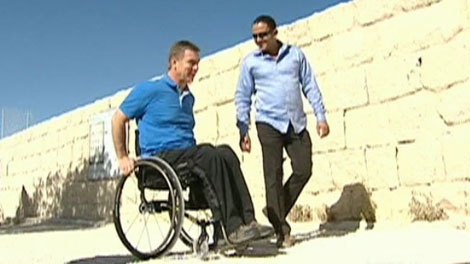VANCOUVER – The first time Robb Dunfield ever met someone who permanently used a wheelchair, the 19-year-old felt overwhelmed at realizing some people live without perfect use of their bodies.
Three months after that late 1970s visit to a Vancouver extended care facility, Dunfield shattered his own spine tumbling off a third-floor balcony, landing on his head.
Paralyzed from the neck down with an injury no one had previously been known to survive, Dunfield recalls that when he could eventually venture outdoors in his own wheelchair, people stared so hard they sometimes walked into walls.
Seven years or so later, he met a paraplegic man two years his senior in Edmonton who was living nothing of the usual shut-in lifestyle. This man had wheeled the equivalent of two marathons that day.
Rick Hansen wore ice packs like bandages over his throbbing shoulders and hands — but his eyes sparkled.
“This guy is special, it doesn’t matter he’s in a chair,” Dunfield thought to himself, a stark contrast to an earlier view that the man rolling his way around the world was just plain crazy.
The impression stuck and it swayed millions of people more who rooted for Hansen as the extreme athlete propelled himself to national hero status. Wheels to the dirt, Hansen charted an enduring course for inverting attitudes around people with disabilities and advancing medicine for spinal chord injury.
A quarter-century later, Hansen is aiming to galvanize a new generation of Canadians by embarking on what he considers only “symbolically halfway” in his life’s work towards generating a cure.
On August 24, Hansen launches a cross-Canada relay of 7,000 people from Cape Spear, Nfld., that will trace virtually the same route as his original Man in Motion tour. Starting exactly 25 years after he began this country’s portion of the trek, most participants will be selected through an online contest in the spring that lauds people who’ve made meaningful contributions to their community.
The relay will cover 12,000-kilometres as it passes through more than 600 communities in all provinces and territories, culminating — just like 25 years ago — in Vancouver.
“The tour was over, but the cure and accessible communities had just begun,” Hansen reflected in a recent interview. “The challenge I gave to people at BC Place, when there was 50,000 people at the end, was ‘I’ve started this movement, but it’s your turn.”‘
It’s time again for Canadians to rally to his call, he said.
The nine-month event will share the hallmarks of the Olympic torch relay that led up to the 2010 Vancouver Winter Games, though Hansen noted his team first envisioned this expedition more than 10 years ago. Participants will travel about 250 metres each — using modes that range from running and skiing, kayak and motorcycle, to adaptive rowing — while handing off a medal designed by the Royal Canadian Mint.
Each day of 40 to 80 kilometres will conclude with a celebratory gathering meant to educate and encourage building accessible and inclusive communities.
Hansen was one of five final torchbearers at the Winter Olympics opening ceremonies, alongside hockey great Wayne Gretzky.
In his heyday, Hansen could suffer a somersault in his wheelchair yet keep going to win the race. This time he’ll mainly attend relay stops in major cities.
“Could I do it again? Maybe,” the now 53-year-old said of attempting another singular tour, chuckling. “I wouldn’t want to find out. Once was enough, for sure, but at the same time, as time goes on it’s easy to forget just how gruelling a physical challenge it was.”
While there won’t be the same drama that accompanies a single protagonist’s every turn, Hansen believes by including thousands in this online era, the relay’s impact will be multiplied.
“Through their stories and through their involvement there’s a direct link to a local community, a province or a country, and in my mind we’re going to see a lot more participation than we did during the original tour,” he said.
But they won’t be passing a bucket around for coins like the first time. Fundraising has instead been an ongoing effort through the two years of the Rick Hansen Foundation’s 25th anniversary programming.
His overall campaign goal is $250 million.
This new, private funding, seen by the research community as a somewhat more stable source than monies from governments, will help speed progress, said Dr. Brian Kwon, an orthopedic surgeon and spinal cord repair researcher at the University of B.C.
Close to 86,000 Canadians currently live with spinal cord injury and it’s estimated that 90 per cent of knowledge about the condition has been discovered in the years since Hansen first raised public attention.
Kwon said while there’s no guarantee a cure-all will be developed by Hansen’s future 25-year target, it’s “definitely possible” scientists will establish treatments that will bring “meaningful improvement.” For example, patients may regain bladder control, as opposed to being able to walk again, which for some is a greater priority.
Kwon is hoping the relay inspires youth to pursue careers in medicine around spinal cord injury like Hansen did for many kids the first time.
“If all of us are trying to put our pieces of the puzzle together, ideally, the whole process is going to be accelerated if we get more people in the game,” Kwon said.
Decades have now passed since Hansen would have “sold my soul” to get back his perfectly functioning body. But with all he’s accomplished in his dust, and a 25-years-from-now mark on his calendar for “putting the wheelchair in a museum,” he wouldn’t change a thing.
“Now I feel like one of the luckiest guys on the planet,” he said. “I would never trade my life over those years for the use of my legs.”
